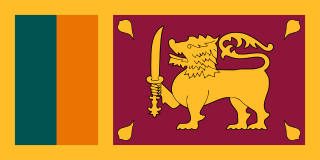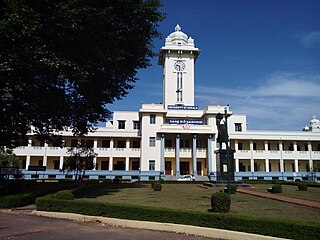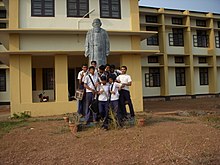An examination board is small board organization that sets examinations, is responsible for marking them, and distributes results. Some are run by governmental entities; some are run as not-for-profit organizations.
University admission or college admission is the process through which students enter tertiary education at universities and colleges. Systems vary widely from country to country, and sometimes from institution to institution.

Education in Portugal is free and compulsory until the age of 18, when students usually complete their year 12. However, only one of those requirements is necessary. The education is regulated by the State through the Ministry of Education. There is a system of public education and also many private schools at all levels of education. The first Portuguese medieval universities, such as the University of Coimbra, were created in the 13th century, and the national higher education system is fully integrated into the European Higher Education Area.
The Western Australian Certificate of Education (WACE) is the credential awarded to students who have completed senior secondary education in the state of Western Australia. It is the Western Australian graduation certificate of the Australian Senior Secondary Certificate of Education. Students are required to meet various breadth and depth requirements, achievement standards and literacy and numeracy standards across their final years of schooling. As of the 2020 WACE, there are 106 courses available for students to study. Many WACE students are awarded an Australian Tertiary Admission Rank (ATAR), summarising their results across all areas of study into one ranking for the purposes of university admission. Students may choose from ATAR courses, which count directly towards their ATAR, Vocational Education and Training courses, which are more practical courses and can lead to further vocational opportunities, and, from 2021, General courses, which provide pathways to university, employment, or further vocational education and training. From 2010, the WACE replaced the Tertiary Entrance Exam (TEE), as the standard academic examination for school leavers in Western Australia.

Education in Sri Lanka has a long history that dates back two millennia. While the Constitution of Sri Lanka does not provide free education as a fundamental right, the constitution mentions that 'the complete eradication of illiteracy and the assurance to all persons of the right to universal and equal access to education at all levels" in its section on directive principles of state policy at (27. Sri Lanka's population had an adult literacy rate of 96.3% in 2015, which is above average by world and regional standards. Computer literacy in 2017 28.3% and phone users in 2017 105%, website users 32% in 2017. Education plays a major part in the life and culture of the country, which dates back to 543 BC. Sri Lanka's modern educational system modeled after Christian missionary system was brought about by its integration into the British Empire in the 19th century. Education currently falls under the control of both the Central Government and the Provincial Councils, with some responsibilities lying with the Central Government and the Provincial Council having autonomy for others. Education institutions with a tradition dating back to 5 BC are largely ignored by the state.
Kerala Engineering Architecture Medical (KEAM) is an entrance examination series for admissions to various professional degree courses in the state of Kerala, India. It is conducted by the Office of the Commissioner of Entrance Exams run by the Government of Kerala.

Education in Nigeria is overseen by the Federal Ministry of Education. The local authorities take responsibility for implementing state-controlled policy regarding public education and state schools. The education system is divided into Kindergarten, Primary education, Secondary education, and Tertiary education. Nigeria's federal government has been dominated by instability since declaring independence from Britain, and as a result, a unified set of education policies is yet to be successfully implemented. Regional differences in quality, curriculum, and funding characterize the education system in Nigeria. Currently, Nigeria possesses the largest population of out-of-school learning youths in the world. The education system in the Southern Nigeria is different from the North. Most northerners have memorised the Holy Qur'an and use that as their education. The educational systems in Nigeria are divided into two the public where the student only pays for PTA while the private where students pay school fees and some other fees like sports, exam fees, computer fees etc. and they are costly

The importance and antiquity of education in Kerala are underscored by the state's ranking as among the most literate in the country. The educational transformation of Kerala was triggered by the efforts of the Church Mission Society missionaries, who were the pioneers that promoted mass education in Kerala, in the early decades of the 19th century. The local dynastic precursors of modern-day Kerala—primarily the Travancore Royal Family, the Nair Service Society, Sree Narayana Dharma Paripalana Yogam and Muslim Educational Society (MES)—also made significant contributions to the progress on education in Kerala. Local schools were known by the general word kalaris, some of which taught martial arts, but other village schools run by Ezhuthachans were for imparting general education. Christian missionaries and British rule brought the modern school education system to Kerala.
VSSC Central School is an English-medium co-educational public school located in the suburb of Thumba, in Thiruvananthapuram, in the Indian state of Kerala. The school offers programmes from grades 1–12. Admission is restricted to children of the employees of the Indian Space Research Organisation. It is a full-fledged senior secondary school, offering five streams at the +2 level with almost 1000 students and 60 staff members. It is affiliated to the Central Board of Secondary Education, New Delhi.

Tamil Nadu is one of the most literate states in India. The state's literacy rate is 80.33% in 2011, which is above the national average. A survey conducted by the Industry body Assocham ranks Tamil Nadu top among Indian states with about 100% Gross Enrollment Ratio (GER) in primary and upper primary education.
Higher education in Sri Lanka is an optional final stage of formal learning following secondary education. Higher education, also referred to as tertiary education occurs most commonly universities or degree-granting institutions. These may be public universities, public and private degree-granting institutions which award their own degrees or degrees from foreign universities. High visibility issues include limited capacity of public universities to cater for the demand and opposition to private universities from certain segments.
Vailoppilly Sreehara Menon Memorial Government Vocational Higher Secondary School, commonly known as GVHSS, Ollur, is a vocational higher secondary school situated in Ollur, Thrissur City and run by the state government of Kerala, in India. It is named after the poet Vyloppilli Sreedhara Menon, who served as headmaster from 1936 to 1966.
Seethi Sahib Higher Secondary School is a prominent higher secondary school in Kerala located in Taliparamba, Kerala, India. It was established in 1968. The school is named after former Speaker Seethi Sahib of the Kerala Legislative Assembly. School is noted for the large number of students attending SSLC public exams each year and their good results. According to school website, around 3500 students currently attends Seethi Sahib H S S. Both high school and higher secondary follows state syllabus. Medium of instruction for higher secondary is English like all higher secondary schools in the state and for high school Malayalam and English are available as options.
GVHSS Kadirur, aka Government Vocational Higher Secondary School Kadirur is a Higher Secondary school in Kadirur, Kerala. Established in 1922 is one of the oldest schools in Kannur under the government of Kerala.
RGMHSS aka Rajeev Gandhi Memorial Higher Secondary School is a Higher Secondary School in mokeri, Kerala. Established in 1995, it is a prominent government-aided school in Kannur District.







